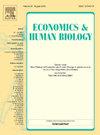Heterogeneous impacts of climate change on morbidity
IF 1.8
3区 医学
Q2 ECONOMICS
引用次数: 0
Abstract
This paper examines the effect of temperature on emergency department (ED) visits using administrative data covering 50 % of the Hungarian population and 3.52 million ED visits from 2009 to 2017. The results show that ED visit rates increase when average temperatures exceed 10°C, primarily driven by mild cases that do not result in hospitalization. Higher humidity amplifies the heat effect, which is also stronger following consecutive hot days. The findings further indicate that the impacts of climate change – both present and future – are substantial. Between 2009 and 2017, 0.66 % of the ED visits were attributed to temperature changes relative to the period 1950–1989. Furthermore, by the 2050s, compared to the first 15 years of the 21st century, the annual ED visit rate is projected to rise by 1.24 %–1.70 %, depending on the climate scenario. A heterogeneity analysis reveals that the effects of high temperatures and the future impacts of climate change are disproportionately greater in lower-income districts, areas with lower general practitioner density, and among younger adults.
气候变化对发病率的异质性影响
本文使用涵盖匈牙利人口50% %和2009年至2017年352万次急诊科就诊的行政数据,研究了温度对急诊科(ED)就诊的影响。结果表明,当平均气温超过10°C时,急诊科就诊率增加,主要是由轻度病例引起的,不导致住院。较高的湿度会放大热效应,在连续炎热的天气下,热效应也会更强。研究结果进一步表明,气候变化的影响——无论是现在的还是未来的——都是巨大的。在2009年至2017年期间,0.66 %的急诊科就诊归因于相对于1950-1989年期间的温度变化。此外,到2050年,与21世纪前15年相比,根据气候情景,预计每年的ED访问量将增加1.24 % -1.70 %。异质性分析显示,在低收入地区、全科医生密度较低的地区和年轻人中,高温和气候变化的未来影响不成比例地更大。
本文章由计算机程序翻译,如有差异,请以英文原文为准。
求助全文
约1分钟内获得全文
求助全文
来源期刊

Economics & Human Biology
医学-公共卫生、环境卫生与职业卫生
CiteScore
4.50
自引率
12.00%
发文量
85
审稿时长
61 days
期刊介绍:
Economics and Human Biology is devoted to the exploration of the effect of socio-economic processes on human beings as biological organisms. Research covered in this (quarterly) interdisciplinary journal is not bound by temporal or geographic limitations.
 求助内容:
求助内容: 应助结果提醒方式:
应助结果提醒方式:


